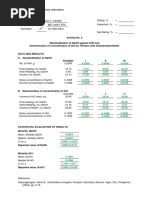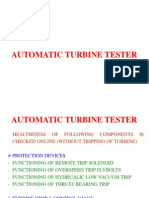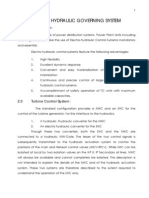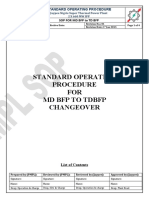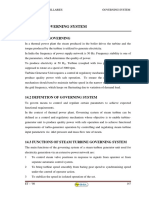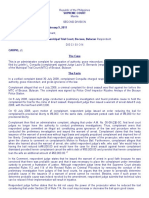Starting Device Not Operating From Control Room &EHTC Hunting
Uploaded by
Charu ChhabraStarting Device Not Operating From Control Room &EHTC Hunting
Uploaded by
Charu ChhabraPROJECT : NEYVELI THERMAL POWER STATION II, UNIT NUMBER 6, 210 MW. PROBLEM : 1.
Starting device not operating from control room. 2. EHTC hunting when changed over to load control at load of 40 MW.
1. Starting device not operating from control room.
Problem: The servicing of all the governing system components was carried out during overhaul. There were no problems during checking and setting of governing characteristics. While checking the operation of starting device from control room, it was observed that the device was not operating. The power supply module was checked and found to be healthy. The power supply was getting extended whenever command was given from control desk. But it was noticed that the power supply module was tripping on overload protection within few seconds of command. While giving command, observation was made at local and found that motor was not rotating. Analysis: The starting device motor is provided with magnetic brake and hence it is not possible to check the freeness of motor by rotating manually. The brake will get released on giving command. The cable terminations of brake system was checked and found healthy. The motor was decoupled and operation of the motor was checked by giving command at control room. It was found that the motor was rotating freely in both directions of commands in decoupled condition. Also, the adjusting gear was rotating freely by hand and starting device was free to operate by hand wheel.
The coupling (part number 25 and 26 in the figure) is within the housing and not visible after assembly of motor. The extended shaft of the motor with coupling hub was rotated during assembly and proper coupling was ensured. The motor is bolted to the housing of the adjusting gear and after tightening the coupling gap (gap between part numbers 25 and 26 in the enclosed figure) should be 0.5 mm. Measurements of length of extended shaft with coupling hub and depth of the other part of coupling in adjusting gear were made and found that there were no gap in coupling. Also, while tightening the motor, the shaft was forcing against the worm wheel of adjusting gear (as the measurements indicated interference at coupling) and motor shaft was getting jammed and unable to rotate by motor, causing the motor to trip on overload. Conclusion: For maintaining coupling gap, 1 mm shim was introduced between motor and the housing of adjusting gear. After assembly it was found that the starting device was operating from control room and the current was normal during operation. It was advised to check the coupling gap, whenever motor was replaced for starting device or speeder gear.
Figure .1 Adjusting gear for starting device
2. EHTC hunting when changed over to load control at load of 40 MW. Problem: The unit was rolled and synchronized with EHTC in service. During rolling, at warm up speed, rated speed and during synchronization, the behavior of EHTC was smooth. While changing over to load control and loading beyond 40 MW, severe hunting of EHTC and control valves was noticed. The machine was immediately changed over to hydraulic governing and further loading was done. Analysis: The behavior of EHTC and control valves at rolling and speed control mode at low load was smooth. Also, during checking of characteristics the behavior was smooth. Hence it is suspected that the load controller settings might have got disturbed and is to be tuned. But as per C & I engineer, the settings are same as pre-overhaul values. The balance voltage was checked and found to be 3.5 volts, instead of 1 volt. The same was readjusted to 1 volt. With EHTC in isolated position, the speed control loop was checked and found that the feedback was not smooth even after adjustment of balance voltage. It was decided to check the freeness of the pilot valve. The moving coil with sleeve was removed. The pilot valve was observed for its rotation by admitting and isolating the control oil many times. It was found that at times, the pilot valve does not rotate. The pilot valve was removed and serviced again. The holes of oil jet for rotation in the disc of the pilot were thoroughly cleaned and assembled back. The rotation of pilot with admission of control valve was checked many times and the pilot was rotating smoothly. The behavior of the EHTC in isolated condition was checked and found to be smooth. The machine was changed over to EHTC control at load of 150 MW and the behavior was smooth.
Conclusion: While checking the characteristics of EHTC, the behavior was smooth. It is necessary to check the rotation of pilot and its consistency by admitting and isolating control oil many times.
You might also like
- Dadri Coal Failure of Electro Hydraulic Converter Ehc Follow Up Piston100% (1)Dadri Coal Failure of Electro Hydraulic Converter Ehc Follow Up Piston6 pages
- Standard Operating Procedure For Hy-Lp Bypass System: ObjectiveNo ratings yetStandard Operating Procedure For Hy-Lp Bypass System: Objective8 pages
- Turbine Stress Evaluator (Tse) Turbine Stress Evaluator)No ratings yetTurbine Stress Evaluator (Tse) Turbine Stress Evaluator)3 pages
- HP Bypass System and Reheater Protection Logic100% (2)HP Bypass System and Reheater Protection Logic11 pages
- SESI-TSPL-OPN-SOP-BTG-074 (MDBFP & TDBFP Paralleling)No ratings yetSESI-TSPL-OPN-SOP-BTG-074 (MDBFP & TDBFP Paralleling)5 pages
- Electro-Hydraulic Turbine Controller: Lets Share Knowledge On100% (5)Electro-Hydraulic Turbine Controller: Lets Share Knowledge On45 pages
- Presentations - 660 MW Governing System Presentation100% (1)Presentations - 660 MW Governing System Presentation49 pages
- Design Features of Governing System LMW and Kwu Turbines100% (3)Design Features of Governing System LMW and Kwu Turbines34 pages
- Problem Faced in Governing After OverhaulNo ratings yetProblem Faced in Governing After Overhaul11 pages
- Over-speeding Turbine During Startup-Due-to-EHG-FailureNo ratings yetOver-speeding Turbine During Startup-Due-to-EHG-Failure6 pages
- Overspeeding of Turbine During First Tolling Due To EHG Failure100% (7)Overspeeding of Turbine During First Tolling Due To EHG Failure6 pages
- January 2023 Report For Muzila Dennis TNo ratings yetJanuary 2023 Report For Muzila Dennis T12 pages
- AOP Bearing Failure Leading To Impellor Failure, 250 MW, 98-99No ratings yetAOP Bearing Failure Leading To Impellor Failure, 250 MW, 98-992 pages
- 3 - 02 International Wire Size ConversionNo ratings yet3 - 02 International Wire Size Conversion2 pages
- Pressure - Temperature Ratings of Plain Endseamless Chromium - Molybdenum Alloy Steel Pipe To Astm A 335 Grade P11 (1 % Chromium - 1/2% Molybdenum)No ratings yetPressure - Temperature Ratings of Plain Endseamless Chromium - Molybdenum Alloy Steel Pipe To Astm A 335 Grade P11 (1 % Chromium - 1/2% Molybdenum)1 page
- 2 - 15 Dimensions of Steel Tubes-BS-1387No ratings yet2 - 15 Dimensions of Steel Tubes-BS-13871 page
- Pressure - Temperature Ratings of Plain End Seamless Carbon Steel Pipe To ASTM A53 Grade B and ASTM A 106 Grade BNo ratings yetPressure - Temperature Ratings of Plain End Seamless Carbon Steel Pipe To ASTM A53 Grade B and ASTM A 106 Grade B1 page
- 2 - 17 Weights of MS ERW Pipe ASTM A-120 SCH 40No ratings yet2 - 17 Weights of MS ERW Pipe ASTM A-120 SCH 401 page
- Brother Dcp 9030cdn l3510cdw l3517cdw l3550cdw l3551cdw Hl l3290cdw Mfc 9150cdn 9350cdw l3710cw l3730cdn l3735cdn l3745cdw l3750cdw l3770cdw Parts ManualNo ratings yetBrother Dcp 9030cdn l3510cdw l3517cdw l3550cdw l3551cdw Hl l3290cdw Mfc 9150cdn 9350cdw l3710cw l3730cdn l3735cdn l3745cdw l3750cdw l3770cdw Parts Manual39 pages
- Supplementary-Student-Application-Form-2020No ratings yetSupplementary-Student-Application-Form-202013 pages
- Frictionless Spacecraft Simulator With Unrestricted Three Axis Movement For NanosatsNo ratings yetFrictionless Spacecraft Simulator With Unrestricted Three Axis Movement For Nanosats12 pages
- Conquilla vs. Bernardo, A.M. No. MTJ-09-1737, February 9, 2011No ratings yetConquilla vs. Bernardo, A.M. No. MTJ-09-1737, February 9, 20115 pages
- For HDFC ERGO General Insurance Company LTDNo ratings yetFor HDFC ERGO General Insurance Company LTD2 pages
- Phrasal Verbs About Clothes and FashionNo ratings yetPhrasal Verbs About Clothes and Fashion14 pages
- Dadri Coal Failure of Electro Hydraulic Converter Ehc Follow Up PistonDadri Coal Failure of Electro Hydraulic Converter Ehc Follow Up Piston
- Standard Operating Procedure For Hy-Lp Bypass System: ObjectiveStandard Operating Procedure For Hy-Lp Bypass System: Objective
- Turbine Stress Evaluator (Tse) Turbine Stress Evaluator)Turbine Stress Evaluator (Tse) Turbine Stress Evaluator)
- SESI-TSPL-OPN-SOP-BTG-074 (MDBFP & TDBFP Paralleling)SESI-TSPL-OPN-SOP-BTG-074 (MDBFP & TDBFP Paralleling)
- Electro-Hydraulic Turbine Controller: Lets Share Knowledge OnElectro-Hydraulic Turbine Controller: Lets Share Knowledge On
- Presentations - 660 MW Governing System PresentationPresentations - 660 MW Governing System Presentation
- Design Features of Governing System LMW and Kwu TurbinesDesign Features of Governing System LMW and Kwu Turbines
- Over-speeding Turbine During Startup-Due-to-EHG-FailureOver-speeding Turbine During Startup-Due-to-EHG-Failure
- Overspeeding of Turbine During First Tolling Due To EHG FailureOverspeeding of Turbine During First Tolling Due To EHG Failure
- AOP Bearing Failure Leading To Impellor Failure, 250 MW, 98-99AOP Bearing Failure Leading To Impellor Failure, 250 MW, 98-99
- Pressure - Temperature Ratings of Plain Endseamless Chromium - Molybdenum Alloy Steel Pipe To Astm A 335 Grade P11 (1 % Chromium - 1/2% Molybdenum)Pressure - Temperature Ratings of Plain Endseamless Chromium - Molybdenum Alloy Steel Pipe To Astm A 335 Grade P11 (1 % Chromium - 1/2% Molybdenum)
- Pressure - Temperature Ratings of Plain End Seamless Carbon Steel Pipe To ASTM A53 Grade B and ASTM A 106 Grade BPressure - Temperature Ratings of Plain End Seamless Carbon Steel Pipe To ASTM A53 Grade B and ASTM A 106 Grade B
- Brother Dcp 9030cdn l3510cdw l3517cdw l3550cdw l3551cdw Hl l3290cdw Mfc 9150cdn 9350cdw l3710cw l3730cdn l3735cdn l3745cdw l3750cdw l3770cdw Parts ManualBrother Dcp 9030cdn l3510cdw l3517cdw l3550cdw l3551cdw Hl l3290cdw Mfc 9150cdn 9350cdw l3710cw l3730cdn l3735cdn l3745cdw l3750cdw l3770cdw Parts Manual
- Frictionless Spacecraft Simulator With Unrestricted Three Axis Movement For NanosatsFrictionless Spacecraft Simulator With Unrestricted Three Axis Movement For Nanosats
- Conquilla vs. Bernardo, A.M. No. MTJ-09-1737, February 9, 2011Conquilla vs. Bernardo, A.M. No. MTJ-09-1737, February 9, 2011






